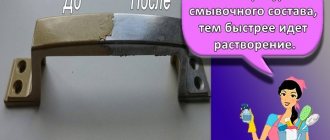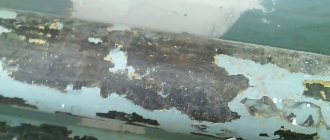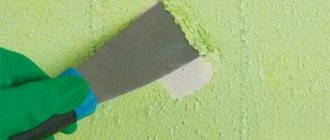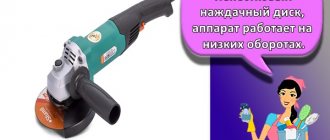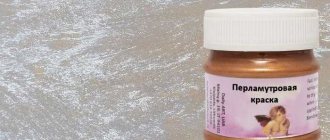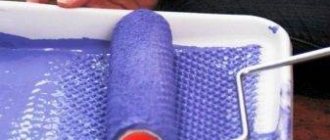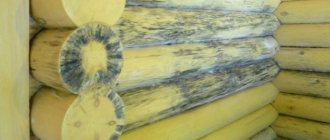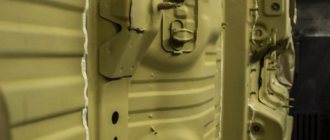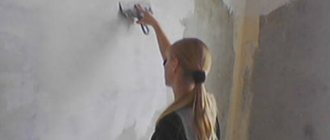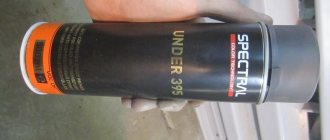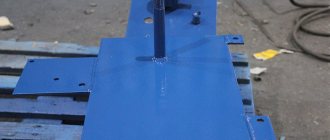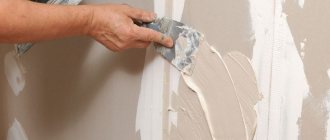Removing old, deteriorated paintwork (paint and varnish) is a problem that we periodically have to face both in production conditions and in everyday life. Unfortunately, for a number of reasons, it is not always possible to apply a new coating over the old coating - for example, due to their incompatibility. Then the question arises - how to remove the old paintwork? And remove it as quickly as possible.
The reason for this situation, oddly enough, is in complete contradiction with the goals of the painting itself and the properties of the paintwork. What goals do we pursue when we are going to paint a surface?
- so that the paint has good adhesion to the surface;
- so that there is an even, uniform coating without streaks, wrinkling and other surface defects;
- so that the coating does not peel off or crack throughout its entire service life.
Therefore, for high-quality surface painting, the following steps are performed:
- first, a primer is applied to the previously prepared surface (in 1 – 2 layers);
- then surface unevenness is leveled with putty;
- then the primed surface is carefully polished;
- after this, enamel is applied (from one to several layers);
- in some cases, a topcoat varnish is applied over the enamel.
As you can see, as a result we have a complex multi-layer coating, which has been completely formed over a long period of operation, and it will be very difficult to remove such a coating. Actually, such a task would not have been undertaken if not for one “but” - quite a lot of time passed, the coating lost its decorative appearance, began to deteriorate and ceased to fulfill its protective functions.
With a peeling, loose coating, everything is clear - pick up a spatula, an iron hand or mechanical brush, a solvent, and begin the painstaking process of removing old paint, where the final result depends only on your diligence, effort and time spent. What if the old coating still has good adhesion to the substrate? What if it needs to be removed without damaging the substrate? What if it needs to be removed in a short time? Of course, there are also mechanical ways to clean the surface of old paint, but even here there is no guarantee against the appearance of microcracks and chips.
In addition, it must be remembered that some surfaces have a porous structure (wood, plaster, drywall, etc.), and removing old paint from it mechanically is, to put it mildly, not an easy task.
How to remove old paint?
Before painting the structure, you should remove the old paint and damaged (corroded) surface, otherwise the new coating will look unsightly and/or may quickly peel off. There are three main ways:
1) Mechanical methods of removing paints
Mechanical - the surface is treated with sandpaper or a wire brush. It involves an abrasive effect on the coating, as a result of which paint particles are removed along with a small layer of the surface.
- Pros: economical, tools available.
- Cons: long, possible damage to the product.
sandblasting paint or rust removal
Petal circle after stripping the paint.
Stripping paint with a wire brush.
Old and new Gtool CD circle.
These are circles made of non-woven material. They are a voluminous web made of thick nylon thread, onto which abrasive grain is applied using glue. In the CD wheel, the distance between the threads forms large pores, which allow you to “throw away” sanding products and not “get greasy” on the wheel, even when sanding very old paint applied in many layers.
Recommended speed is 4,000 rpm. Such revolutions are much more comfortable for the operator and safer than 10-11 thousand when working with metal brushes or CLT.
The structure of the CD wheel allows it to “compress” a little during operation and thereby cushion and process not flat surfaces, but, for example, pipes and slightly curved profiles.
It is aggressive enough to remove hard scale from metal. In this case, the surface geometry will remain unchanged, with only small traces of abrasive grain. Which can be easily covered with subsequent painting.
2) Thermal methods of removing paints
Thermal - the surface is heated with a blowtorch until the paint begins to peel off. It involves the use of various heating devices to soften the paint and then remove it using a spatula or any other sharp tool.
- Pros: prompt, efficient.
- Disadvantages: increased fire hazard, unsafe for health.
3) Chemical methods of removing paints
Chemical - removing paint using removers and solvents. The method is based on the ability of certain chemically active substances to destroy the structure of the dried coating. This occurs due to the content of alkali or solvents in the composition of the substances. As a result, the material may completely dissolve or become very soft.
- Pros: quick and simple.
- Cons: increased toxicity, environmental unsafety.
How to remove paint from a wooden surface?
Most often, professional builders use two main methods to remove paint from wood:
- Thermal — the surface is heated with a hair dryer, then the old coating layer is removed with a spatula.
- Pros: inexpensive, availability of tools.
- Cons: long, can damage the surface.
- Chemical - a special liquid is used to remove old paint from wood. It penetrates deep into the layer of paint or varnish, actively softening it, after which the residue is removed with a spatula.
- Pros: fast, comfortable, economical.
- Cons: toxicity.
Instructions for using the remover
Each wash is accompanied by instructions from the manufacturer, taking into account the features of the specific composition (you need to study it before use). It is necessary to prepare personal protective equipment - a respirator, goggles and gloves to protect yourself from toxic fumes and droplets of the substance on the skin.
To remove old paint you will need the following tools and materials:
- suitable type of wash;
- solvent;
- primer;
- brush or spray if the remover is liquid;
- sandpaper;
- putty knife.
Before starting work, the surface must be cleaned of contaminants and degreased so that only the paint reacts with the chemical and the effectiveness of the product is better. Then you can start cleaning the metal:
- The product is applied to the surface in the amount specified in the instructions and distributed over it in an even layer.
- The metal is covered with plastic film.
- You should wait a while for the product to take effect. Depending on the manufacturer, type of paintwork material, thickness of its layer, air temperature and other factors, this can take from several minutes to an hour.
- When the coating begins to swell and lag behind the base, the paint is scraped off with a spatula.
- The remaining material is erased with sandpaper.
- The surface is wiped with solvent and primed for new painting.
Using chemicals to remove old paint is the most convenient way to clean a metal surface. The risk of damaging the base is minimal; the main thing is to choose the right composition and follow the instructions exactly.
When can you do without removing paint?
Before removing the old layer, you need to make sure that this labor-intensive procedure is really necessary.
When deciding to restore or decorate wooden surfaces, many are faced with a difficult task and cannot decide whether to remove the old coating or paint over the old one. The answer to the question depends on the condition of the old layer and its thickness.
If the previous layer is thin and has no damage in the form of cracks or blisters, then it is quite enough to treat it with sandpaper to remove the gloss and you can safely paint it with a similar paint.
However, if the previous layer is too thick or contains several layers in a row, then, of course, it must be removed.
If the coating has cracks or has become too uneven due to a large number of layers, then removing the old paint is necessary.
Also, washing off the paintwork is necessary when applying another type of paint that does not match the one already applied.
In other cases, it is enough to simply apply a layer of material over the old one with a primer.
To do this, you need to clean the coating, sand it, apply a layer of primer and only then paint.
Useful tips
The process of cleaning metal is very complex and time-consuming. However, if you take into account the following tips, you can make the procedure easier and more effective:
- Typically, paint removers are quite effective, however. If you first wash the surface thoroughly with warm water and soap, this will allow the remover to penetrate deeper into the paint layer and enhance its effect.
- Often the composition used evaporates too quickly. In order to prevent this, wax or paraffin is added to the composition. However, some cleaning products do not contain such ingredients. In this case, the situation can be corrected using plastic film. After applying the remover, it is enough to cover the metal with a layer of polyethylene so that evaporation slows down to an acceptable degree.
Processing old car body paint Source gidpokraske.ru
Chemical methods for removing paint and varnish coatings
But there are surfaces on which paintwork adheres well, and at the same time it can be removed quickly enough (plastic, metal, glass, ceramics, etc.). In this case, it is most advisable to use removers - special compositions designed for removing old coatings. The wash softens both the enamel layer and the layers of primer underneath it, and this allows you to clean the surface using the same spatula.
Regardless of the brand of remover, the set of actions when working with them is the same:
- first, the entire old coating is thoroughly cleaned of any kind of contamination;
- then the remover is applied and it is necessary to wait until it softens the coating and begins to penetrate into its thickness under the influence of diffusion forces (usually this will take from 2 to 30 minutes);
- when bubbles and cracks appear on the surface, the coating is removed using a spatula and a rag moistened with a solvent;
- At the end of the work, the surface is wiped from residues of the wash with a rag with a solvent.
When working with remover, you need to remember two things:
1) under no circumstances should the remover be allowed to dry on the surface;
2) use personal protective equipment - safety glasses, rubber gloves, respiratory protection.
Pay attention to some nuances of using washes:
- before applying the remover to the surface, you need to remove all peeling areas of the coating with a spatula;
- if there are traces of corrosion on the surface, then it is necessary to remove loose sheet rust by any means;
- even if you are confident in the effectiveness of the remover used, you should not apply it to a smooth, glossy surface if it is also old; Be sure to first treat it with sandpaper with a grit of at least 120;
- if you choose between liquid and gel wash, then the thicker one is preferable;
- A very good technique for working with the presented preparations is to use plastic film: after applying the remover, cover the treated surface with film, thus creating a kind of greenhouse effect. Some washes contain waxes to create a greenhouse effect.
Types of washes classification.
All types of washes are divided into two large groups: universal and specialized. Universal compositions are designed to remove any paints and varnishes from wooden surfaces. They are capable of dissolving paints and varnishes both water-based and those containing organic solvents.
The purpose of specialized removers is to soften only certain types of paints.
For example, there are separate remover compositions for removing textured, oil-based and other types of paintwork materials.
Specialized removers are considered more effective, since their development takes into account the characteristics of specific types of dyes. At the same time, specialized formulations are more expensive.
Removers are produced in the form of liquids, jelly and dry substances for further dissolution. When choosing a cleaning composition, it is necessary to proceed from the circumstances: for example, a jelly-like paste adheres well to wood, and therefore will not drain from vertical surfaces.
But liquid removers are the best choice if you have to clean a surface that has small parts or fine threads. If we are talking about expensive furniture (especially those covered with veneer), you need to choose a liquid that can be removed with white spirit, since if this is not done in time, the wood fibers of the product will swell.
Paint removers are usually based on one of the following chemical compounds:
- Organic solvent . These can be a variety of chemically active agents, for example, benzene, toluene, acetone, turpentine and similar compounds. They are excellent for removing epoxy coatings (resins), alkyd paints, and oil-based paints.
- Acid . Usually sulfuric or hydrochloric acid is used. Removers based on them best dissolve acrylic paints, epoxy compounds, polyurethane, and neutralize pockets of corrosion. The disadvantage of such chemical compositions is that with prolonged exposure to the surface they can damage the metal. Accordingly, after application and treatment they must be neutralized with an alkaline solution.
- Lye . Typically this is sodium hydroxide (NaOH). Caustic soda-based metal paint removers are excellent for removing drying oil-based paints, as well as other decorative materials. Please note that these are absolutely NOT suitable for treating aluminum surfaces, as they can damage them by entering into a chemical reaction.
When choosing a particular paint remover, you should always pay attention to its base, since this will not only allow you to choose the most effective product in a particular case, but also not harm the surface being treated. Therefore, always read what is written in the instructions!
Types of Paint Removers
On store shelves, car paint removers can be found in three physical states:
- Liquid . This type of paint remover is best suited if it is to be applied to a relatively flat surface over a large area. Another option is with immersion. Usually sold in small jars or canisters. To work with liquid, you need a brush or a bottle with a spray trigger.
- Aerosols . Using aerosol cans, you can spray the remover on surfaces of almost any shape, as well as apply it to hard-to-reach places. Working with them is simple and convenient.
- Gel . It can be applied to inclined and even vertical surfaces to be treated. Gels have high adhesion and penetrate perfectly into the paint, dissolving it. The disadvantage of this state of aggregation is the inconvenience when applying it to the surface since a brush or roller is required when processing large surfaces.
The choice of state of aggregation depends on the goals set, the availability of the surface to be treated, the availability of funds in stores, as well as the ratio of price and quality of action.
The most popular brands of washes
SD remover (sp) is a composition based on a bouquet of organic solvents - acetone, toluene, ethyl acetate and alcohols - ethyl and butyl. It is a transparent liquid and is used to remove old coatings based on oil, alkyd and alkyd-styrene paints.
Remover SD (SP) is applied to the surface in bulk. After the old coating has swollen (after 3 minutes), it should be removed with a brush or spatula.
Guaranteed shelf life is 4 months from the date of manufacture.
SP-6 remover is used to remove old paint and varnish coatings based on glyphthalic, pentaphthalic, acrylic, epoxy, melamine-formaldehyde and other resins from the surface of ferrous metals, both cold and hot (up to 150 ° C) drying. The remover is a composition based on polyvinyl chloride chlorinated resin, acetic acid, petroleum paraffins and organic solvents. Paraffins are added to the remover to create a “greenhouse effect” on the surface being cleaned from paint.
SP-6 remover is applied with a brush or broom in a uniform, dense layer. The thickness of the applied remover layer depends on the thickness of the paint coating being removed. Leave for 30 minutes when removing cold-drying paint and varnish and 40 minutes when removing hot-drying paint. Since it is a fairly thick, homogeneous liquid, it can be used to process surfaces of various configurations. The wash does not cause corrosion of the metal substrate.
Guaranteed shelf life is 12 months from the date of manufacture.
SP-7 remover is used to remove various old paint and varnish coatings: alkyd-acrylic, polyacrylic, alkyd and oil-styrene, melamine, polyvinyl acetate, epoxy putties and primers, as well as complex coatings. The remover can also be used to remove some types of powder coatings. It is a viscous homogeneous mass (from light brown to dark brown), does not drain from the surface being treated, which allows you to remove old paint from surfaces of various configurations on site without dismantling it in a very short time. The SP-7 remover, like SP-6, does not have a corrosive effect on the metal being processed.
Apply the wash evenly onto the work surface in a thin layer of 1–2 mm with a brush or spatula and leave for 7–10 minutes. After loosening or swelling of the old paint coating, it is removed with a stiff brush or spatula. If the thickness of the old paint coating exceeds 40 microns, re-treatment with a remover is allowed. Residues of the remover can be removed with a solvent (for example, acetone or solvent 646).
Guaranteed shelf life is 6 months from the date of manufacture.
AFT-1 remover is intended for removing old oil, nitrocellulose, glyphthalic and a number of other paint and varnish coatings. It is a suspension of paraffin in organic solvents (solution with sediment). Paraffin is added to the remover to create a “greenhouse effect” on the surface being cleared of paint.
The wash is preheated in a water bath to 40-50 °C to obtain a clear solution. It is applied with any type of paint sprayer or brush; after lifting, wrinkling, softening or peeling of the coating, it is removed with a brush or spatula. If necessary, this operation can be repeated. Washing action – no more than 20 minutes. The wash does not cause corrosion of the metal substrate.
Guaranteed shelf life is 6 months from the date of manufacture.
Remover AS-1 is a liquid from light yellow to brown in color, without foreign inclusions, and is a mixture of active solvents and auxiliary additives. Designed for removing old paint coatings based on vinyl, pentaphthalic, glyphthalic, urethane and epoxy binders.
Wood bleach without chlorine - allows you to remove from wood green plaque, rust and interfiber contaminants that form on a wooden surface as a result of high humidity and precipitation, freezing and unfreezing cycles, and other unfavorable conditions.
The remover is applied by dipping, as well as using a brush or swab. The thickness of the applied remover layer depends on the thickness of the paint coating being removed. The rinse is kept for 15 minutes. After softening, swelling and swelling of the old paint and varnish coating, it is removed with a stiff brush, spatula or other method. The wash also does not cause corrosion of the metal substrate.
Guaranteed shelf life is 6 months from the date of manufacture.
In conclusion, I would like to note that removers based on active solvents are used to remove paintwork from many surfaces - wood, metal, concrete, ceramic, glass, but in no case from plastic. When trying to remove old paint from a plastic surface, it is very likely that the substrate itself will be “washed off” along with the paint.
Removers are used when you need to get rid of old paintwork. Of course, you can get rid of it by mechanical surface treatment. But this is a very labor-intensive process that does not guarantee its complete safety from damage. In general, in an amicable way, you should use special washes - SP-6 , SP-7 , SD and AFT-1 , which have proven themselves to be effective on paint and varnishes.
Remover SP-6 , which is a solution of PVC resin and paraffin in a mixture of active organic solvents, is usually used to quickly and easily dissolve paint based on pentaphthalic, glyphthalic, acrylic, epoxy, melamine-formaldehyde and other resins, both cold and and hot drying. Apply the remover to the surface with a brush or brush, wait about 40 minutes, after which we begin cleaning the paint. We clean off the swollen old paint with a spatula or brush.
A mixture of active organic solvents, disintegrants and thickeners - SP-7 - looks like a white emulsion and acts much faster than SP-6 remover. Already 10 minutes after application, the old paint coating is destroyed (loose or swells) and can be removed. In addition, SP-7 is somewhat more economical than SP-6, since less is required to remove a square meter of coating. Very popular for quick and high-quality removal from surfaces of old paints and varnishes based on alkyd-acrylic (AS), oil-styrene (MS), melamine (ML), polyvinyl acetal (VL), epoxy putties and primers ( EP 0010 , EP 0020), as well as complex coatings consisting of the above materials. When performing work with SP-7 wash, it is necessary to use a filtering respirator (the pungent smell of ammonia).
To remove old paintwork from metal surfaces, use a special remover SD(SP) , consisting of a mixture of acetone, benzene and acetic acid esters. This transparent liquid begins its action to remove old oil and varnish coatings within 3 minutes after application. The washing effect of the remover is manifested in the swelling and wrinkling of the varnish film.
Oil paint and paint based on cellulose nitrate literally after 15-20 minutes easily respond to the AFT-1 , which is a solution of cellulose nitrate and paraffin in a mixture of organic solvents (acetone, formal glycol and toluene or xylene). However, it is worth noting: to achieve the desired result, you will have to use this remover very generously - 250 g per sq.m. For comparison, the consumption of SP-7 wash is 150 g/m2, and SD-170 g/m2. AFT-1 remover is a suspension of paraffin in organic solvents (solution with sediment). Paraffin is added to the remover to create a “greenhouse effect” on the surface being cleared of paint.
Requirements for chemical compounds for removing paint and varnish coatings
Choosing the best product to remove paint from metal surfaces is always a compromise decision. So, before purchasing, be sure to analyze the following composition parameters:
- Specialization . Thus, paint removers are: universal, for oil-based coatings and water-based coatings, express removers, for powder paints.
- Presence of odor . Often, cheap paint removers have an unpleasant, “chemical” odor, which is not only unpleasant for a person’s sense of smell, but also harmful to his body. Accordingly, it is advisable to choose formulations whose instructions clearly state that they are odorless. This is especially true if the work is supposed to be performed indoors without forced ventilation.
- Paint remover consumption . Everything is simple here - the larger the surface that can be treated with a certain volume of product, the better.
- Application method . Small metal parts can be immersed in a container that has previously been filled with liquid paint remover. If we are talking about a large part (as is the case in most cases), then manual application takes place using a brush, roller or spray gun.
- Adhesion and thixotropy (the property of sticking to an inclined surface). These properties are relevant if it is intended to process, respectively, inclined or vertical surfaces. For horizontal surfaces this does not matter.
- Corrosivity . If a rust remover is highly corrosive, there is always a risk that the product may damage the thin-walled product. Accordingly, it is advisable to choose a remover with a low rate of corrosiveness and strictly control the residence time of the substance on the treated surface (no more than half an hour).
- Safety . In this case we mean fire and explosion safety. This factor is important for large-volume containers, for example, those stored in a car service center. They must be provided with the correct storage conditions, in particular, away from open sources of fire and heating devices.
- Application temperature . This indicator is important if paint removal is planned in winter in an unheated room. In particular, you need to pay attention to the information on the packaging about the temperature range of operation and storage (use is allowed only at positive temperatures).
Alternative chemical methods for removing paint and varnish coatings
In addition to cleaning agents that are sold in stores and markets, you can use “folk” remedies—homemade compositions— remove old paintwork
1) You will need a 10% solution of ammonia, 1 liter of water and 2.5 kg of chalk. Ammonia is dissolved in water, after which chalk is added. Having mixed the resulting mixture very thoroughly, it is applied to the surface and left for 3.5 - 4 hours. During this time, the paint will absorb this solution and easily separate from the surface being cleaned.
2) You can soften old oil paint with the following composition: ammonia and turpentine in a ratio of 2:1. The composition is applied to the surface with a brush, after softening the paint is cleaned off with a spatula, the surface is washed and dried.
3) Old oil paint can be removed with a solution containing 1.3 kg of quicklime, water and 0.45 kg of potash. The solution, diluted to a creamy state, is covered with the surface to be treated for 12-13 hours, and then the paint is scraped off with a spatula, the surface is washed with water and dried.
In addition, old oil paint can be burned off with a blowtorch. Under the influence of a flame directed at the painted surface, the old paint layer swells - it is immediately cleaned with a spatula, since cooled paint is more difficult to scrape off. This method is used for small volumes of work and, as a rule, when cleaning plastered or stone surfaces, less often - wooden ones.
Caustic soda solution
You can use either regular caustic soda or a solution that, in addition to soda, includes oatmeal and water. When using this chemical, do not forget about safety precautions (safety glasses, gloves).
Instructions for using caustic soda:
- We dilute baking soda in a container with water.
- Apply the solution with a wide brush. The remover must be distributed sequentially, without gaps on the surface.
- We wait until the soda saturates the wood. After a while, the soda will begin to corrode the paint, and the coating will become covered with bubbles.
- Remove the paint layer with a metal spatula. If there are pits in the surface, you can use a chisel, small spatula or a piece of sandpaper.
- We wash the wood first with a soap solution and then with a stream of warm water.
- Dry the material well before priming or painting it.
If the paint layer is thick or there are hard-to-reach areas on the surface, it is more effective to use a thick composition. You can achieve thickness by mixing baking soda with oatmeal in water. The waiting time after applying the solution to wood is approximately 1-2 hours.
Bleaching powder
Bleach can be used both as a stand-alone paint remover and as an addition to remover. In the latter case, bleach acts as a bleach. The fact is that after removing the paint, rotting or fungal damage will be revealed. In such cases, stains are inevitable, which bleach will help to whiten.
The paint is removed as follows:
- We dilute bleach in a container with water.
- Apply the chemical to the surface using a hard brush or steel wool.
- As the bleach evaporates, the wood will gradually dry out.
Other chemical cleaning methods
When choosing a paint removal method, you should take into account the principle of “remove like with like”:
- Water-based paints can be removed with warm water, a stiff brush and a rag.
- Oil coatings (paints based on fir or linseed oil) can be softened with turpentine. However, if the layer is thick, this will not be so easy. Oil-based paints are the most difficult to remove.
- Enamel paints begin to peel off after treating the surface with acetone or another solvent.
Use of folk remedies
You can purchase effective formulations in specialized stores, but there are well-proven products that you can prepare yourself. The following describes the most effective of them:
- The most popular is the use of caustic soda (another name is caustic soda).
- If you take 250 ml of ammonia, dissolve it in water and add 2 kg of chalk, then by mixing the composition well, you can get an effective cleaning agent. It looks like a white paste. The mixture is applied to the surface and left for several hours. During this time, the paint will be chemically attacked and swell. Now it can be easily cleaned.
These products are not as effective as specialized ones, but in most cases their use will allow for high-quality surface cleaning.
Precautions and safety precautions when removing paint coatings
As mentioned above, when working with chemicals it is necessary to follow safety regulations. These rules include not only the use of a respirator, safety glasses and gloves, but also other recommendations, including:
- Good lighting in the work area helps prevent injuries.
- To process large items, you need to use a durable table or other flat surface.
- Small parts (bars, planks, etc.) are more convenient and safer to process if they are stationary, for example, clamped in a vice.
- Safety glasses are needed not only to prevent paint drops from getting into your eyes. When working with powder coating materials, pieces of dry paint that have bounced off the surface being cleaned may get into your eyes. These pieces are very sharp and can injure your eyes.
- Also, do not forget about choosing the right shoes. It's better if it's old unnecessary shoes. Its material must be strong enough.
- Some types of washes can be a fire hazard. Therefore, you should work away from open sources of fire or heating equipment. Fire extinguishing means should be located in the immediate vicinity of the workplace.
- The optimal place for cleaning is the street. If this is not possible, it is necessary to ensure good air circulation in the room.
